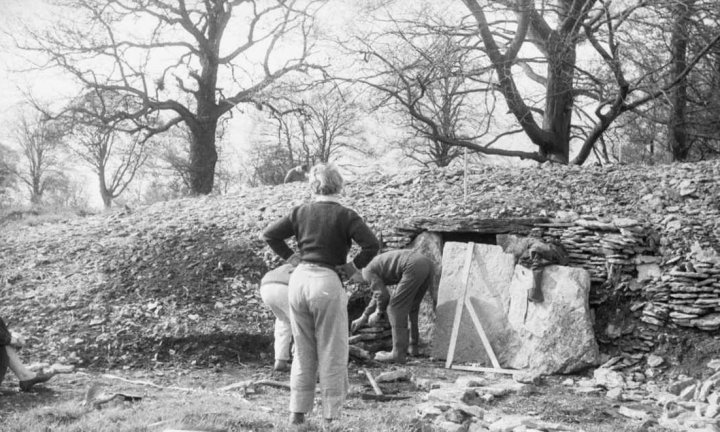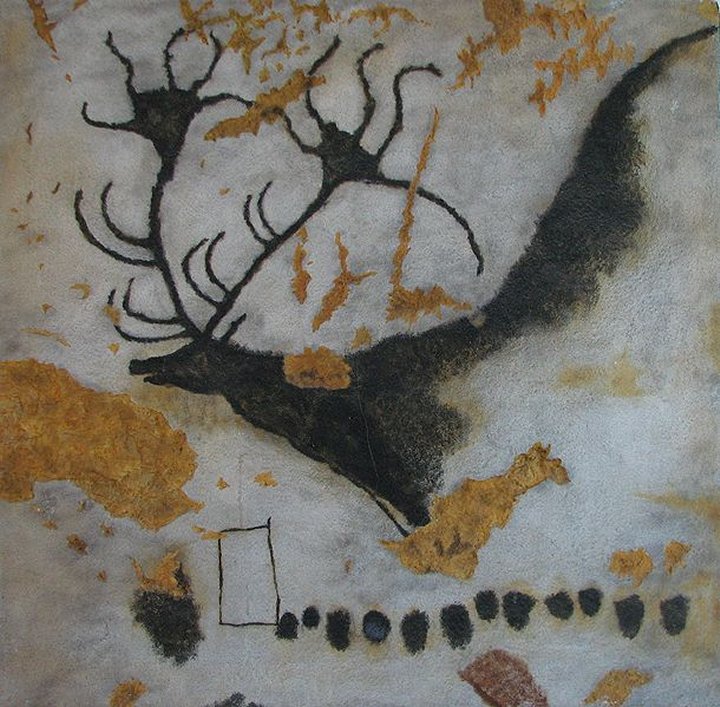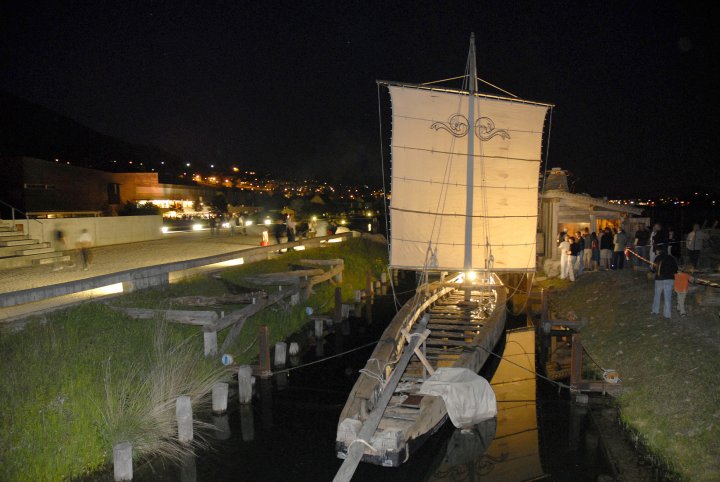
Ratfyn Barrow as viewed from the garden gate

Ratfyn Barrow as viewed from the garden gate





Early Neolithic Stone axe in wooden haft
Ehenside Tarn, Cumbria

The Battersea Shield
Found in the River Themes at Battersea Bridge, London – Around 350-50 BC
The Battersea Shield is one of the finest examples of La Tene, or Celtic art, from Britain. It was deposited in the river perhaps as an offering to the Gods. The shield is decorated with three raised circular panels. The decoration is enhanced with inlayed red glass or enamel. The thin metal and short length of the shield would not have provided adequate protection in battle. Instead the shield was probably made for flamboyant display. It is made of several bronze sheets and a binding strip, held together with bronze rivets. Originally these bronze sheets would have formed the facing for a wooden base, which no longer survives.
Text by British Museum

The Snettisham Treasure
Ken Hill, Snettisham, Norfolk
Buried around 100 BC
Snettisham is one of the key sites of British prehistory. Occupying a wooded hillside near the north-west coast of Norfolk, near Hunstanton, it first began to reveal its secrets in 1948 when five torcs were uncovered during ploughing. Further finds were made at the site in subsequent years. Some of these objects are now in Norwich Museum. The objects now in the British Museum were discovered in 1950 and 1990.
At least 12 groups of objects, known as hoards (hoards A-L), have been found at the site. They were buried in shallow pits, some barely large enough to contain a large torc. In addition to complete torcs, fragments of broken torcs, coins, rings and ingots were also deposited.
Text by British Museum

The Snettisham Treasure
Ken Hill, Snettisham, Norfolk
Buried around 100 BC
Snettisham is one of the key sites of British prehistory. Occupying a wooded hillside near the north-west coast of Norfolk, near Hunstanton, it first began to reveal its secrets in 1948 when five torcs were uncovered during ploughing. Further finds were made at the site in subsequent years. Some of these objects are now in Norwich Museum. The objects now in the British Museum were discovered in 1950 and 1990.
At least 12 groups of objects, known as hoards (hoards A-L), have been found at the site. They were buried in shallow pits, some barely large enough to contain a large torc. In addition to complete torcs, fragments of broken torcs, coins, rings and ingots were also deposited.
Text by British Museum

The Snettisham Treasure
Ken Hill, Snettisham, Norfolk
Buried around 100 BC
Snettisham is one of the key sites of British prehistory. Occupying a wooded hillside near the north-west coast of Norfolk, near Hunstanton, it first began to reveal its secrets in 1948 when five torcs were uncovered during ploughing. Further finds were made at the site in subsequent years. Some of these objects are now in Norwich Museum. The objects now in the British Museum were discovered in 1950 and 1990.
At least 12 groups of objects, known as hoards (hoards A-L), have been found at the site. They were buried in shallow pits, some barely large enough to contain a large torc. In addition to complete torcs, fragments of broken torcs, coins, rings and ingots were also deposited.
Text by British Museum

The Great Torc – Snettisham
Buried around 100 BC
This torc is one of the most elaborate golden objects from the ancient world. It is made from gold mixed with silver and weighs over 1kg. Torcs are made from complex threads of metal, grouped into ropes and twisted around each other. The ends of the torc were cast in moulds and welded onto the metal ropes.
Text by British Museum

Current extent of the UNESCO world heritage site around Avebury, as shown on the Silbury Hill viewing area information board.


Final result of the reconstruction in 1963. John tells me that the right side of the chamber’s stone walling had been robbed away within weeks of Grant King and his team completing their restoration.

Excavation team during the reconstruction in 1963

Grant King and his excavation team during the reconstruction in 1963

The roof of the South Chamber in 1963, before any reinforcement was carried out

The back of the South Chamber in 1963

The South Chamber in 1963 showing the original Neolithic dry stone walling.

The South Chamber in 1963 showing the original Neolithic dry stone walling.

The South Chamber in 1963 showing the iron cage installed in the 1930’s. Note the roof collapse due to frost damage.
John tells me this photo was taken on a Leica II camera, with an army surplus WWII lens mounted on an adaptor he made himself.

The South Chamber being reconstructed in 1909. Excavator might be Cunnington

The South Chamber in 1909 showing the extent of destruction caused by quarrying

The South Chamber in 1909 showing the results of quarrying

Entrance to the Neolithic mines of Spiennes, Belgium

Old illustration showing the different mining methods used at Spiennes

Entrance to the Grotte de Spy (Cave of Spy), in the municipality of Jemeppe-sur-Sambre, province of Namur, Belgium.


Avebury restored showing three circles full of stones, one of the avenues and Windmill Hill

Postcard Seahenge – Holme
The Bronze Age timber circle from the beach at Holme-next-the-Sea, Norfolk by Ray Loveday 2000


When the site was excavated in the 1775, no burials were found, although other large Angevin dolmens had produced evidence of burials. This has led to suggestions that it was not a burial monument. We can never be sure. The site had been put to various uses before any excavations, most notably a barn for many years.

This is claimed to be the largest Angevin type dolmen in France, and maybe the world. The statistics are impressive, 17.3 meters long by 5.4 meters wide and 3.1 meters high. There is also an antechamber which adds another 4 meters to the overall length. The chamber is covered with four huge capstones, the largest of which is 7.6 meters long and weighs 86 tons. An interior stone is not a supporting pillar but probably the remains of an internal partition, which is usually found in these Angevin type dolmens.

Although known as the “little” or small dolmen, this megalith is only upstaged by the largest dolman in France, it’s nearby neighbour, Le Grand Dolmen de Bagneux.

Coate Stone Circle as seen by A.D. Passmore in 1894

Heavy butted pointed Palaeolithic handaxe of Acheulian type found on banks of River Avon, Sutton Benger

Heavy butted pointed Palaeolithic handaxe of Acheulian type found on banks of River Avon, Sutton Benger

Heavy butted pointed Palaeolithic handaxe of Acheulian type found on banks of River Avon, Sutton Benger

Neolithic polished greenstone axe found in Chippenham garden, early 1960’s

Neolithic polished greenstone axe found in Chippenham garden, early 1960’s


Bisons from the Black Hall (Salon noir) of the Niaux cave, replica in the Brno museum Anthropos. Magdalenian Period of Paleolithic art.

Outline of a human hand, dated 27,000 Before Present Era, displayed at the Musée d’Archéologie Nationale (Museum of National Archeology), in the Chateau of Saint-Germain-en-Laye, Paris, France.

The Chauvet horses by Cro-Magnon peoples 31000 BP (Aurignacien)

Megaloceros, painting of the Giant Deer from Lascaux

Cave painting of a Buffaloes at Lascaux

Cave painting of a dun horse (equine) at Lascaux


